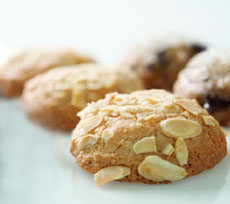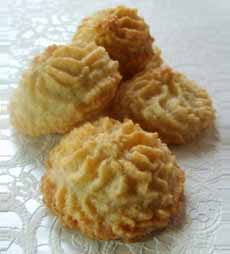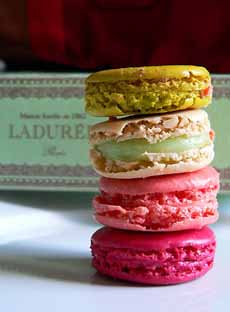
 French-style macaroons from Mad Mac, a NIBBLE Top Pick Of The Week. Photo by Claire Freierman | THE NIBBLE.
December 2006
Last Updated May 2017
|
|
The History Of Macaroons
Page 2: The French Macaron
This is Page 2 of a two-page article. Click on the black link below to visit Page 1.
Amaretti
Amaretti, a variant of macaroon, were invented by Francesco Moriondo, pastry chef of the Court of Savoy, in the mid-17th century.
They were (and are) flavored with chopped bitter almonds or amaretto, bitter almond liqueur.
The Italian word amaro means “bitter,” and the literal translation of amaretti is “the little bitter ones.”
In Italy, crushed macaroons are used in frangipani, a cream filling made by flavoring butter with lemon extract, rum, sherry or brandy.
Macaroon crumbs are often added to ice cream (they are a part of the popular frozen tortoni, named after a 19th century cafe owner). And who wouldn’t enjoy a macaroon crumb topping on pies and puddings.
The concept moved to France with the young bride, Catherine di Medici, and from there different regions created their own specialty variations.
Before Ladurée created the now-iconic meringue sandwich cookie in Paris, other areas were enjoying variations of the Italian macaroon.
|
|

Above: Amaretti-style cookies from artisan baker Pistachia Vera in Columbus, Ohio. Below: Amaretti from a large Italian manufacturer; photo courtesy Hill Coffee.

|
-
Macarons d’Amiens have been made in Amiens since 1855. The small, round cookies are made from almond paste, honey and fruit: similar to amaretti but with fruit instead of almonds.
-
Montmorillon bakers have been making coconut macarons—like the Jewish versions—for more than 150 years. The city is known for its macarons and its macaron museum (see below).
-
Nancy, a city in the Lorraine region, also has a place in macaron history. Catherine de Vaudémont, the Abbess of Remiremont and daughter of Charles III, Duke of Lorraine, founded the Benedictine monastery of Les Dames du
Saint-Sacrement in that city. Strict dietary rules prohibited the consumption of meat. Two nuns mentioned previously,
Sister Marguerite Gaillot and Sister Marie-Elisabeth Morlot, are credited with creating macarons de
Nancy to fit their dietary requirements.
-
In 1792, events leading to the French Revolution prohibited religious congregation. The two sisters took refuge with a Doctor Gormand, at 10 Rue de la Hache. They baked macarons to support themselves, and became known as
the Macaron Sisters, les soeurs macarons [ source].
But now, we turn to the modern fan favorite:
French Macaron Sandwiches
The cookie took a big leap forward at the beginning of the 20th century, when a Parisian baker, Pierre Desfontaines Ladurée, had the idea to join two meringues and fill them with ganache. |
|

Macarons d’Amiens (photo courtesy 196Flavors.com).

Macarons a Montmorillion (photo courtesy 750g.com).

Macarons du Nancy (photo courtesy AlainBatt.com). |
The “original” macaron sandwiches combined two plain almond meringues with a filling of [chocolate] ganache; but today, ganache, buttercream or jam is sandwiched between meringues of seemingly limitless colors and flavors.
He then moved on to conventional flavors chocolate, coffee, pistachio, raspberry, vanilla). Over the decades, these evolved into spectacularly colored and flavored meringue “sandwiches.”
The Parisian bakery Ladurée is now known for its dozens of exciting flavors and colors. In addition to the original flavors, you’ll find Blackcurrant Violet, Salted Butter Caramel, and seasonal flavors like Anise (shown at right), Chestnut, Basil Lime, Orange Blossom, Rose and White Chocolate. Every trip to Paris must include a visit!
|
|

Busting out the colors at Ladurée (photo courtesy La Tartine Gourmande). Quite a difference from the beige macarons that preceded them. |
In Switzerland, what look very much like these colorful cookie sandwiches are called Luxembourgers. They are smaller in size, and even more fragile!
American Macarons
Ladurée-style macaron sandwiches have been the rage in the U.S. since at least the turn of the (21st) century. In addition to the traditional French flavors, you can take a bite from international ones like dulce de leche, Earl Grey tea, matcha and yuzu.
To appeal to the tastes of the general public, you’ll also find flavors such as candy cane, candy corn, cotton candy, maple bacon,
mint
chocolate chip, peanut butter and jelly, pumpkin, Snickers, strawberry cheesecake, salted pretzel, and yes, salted caramel popcorn.
They are made in team colors, painted with celebrity (or celebrant) faces or abstract art, turned into “hamburger” designs (photo below), dusted with gold,
|
|

Busting out the colors at Ladurée (photo courtesy La Tartine Gourmande). Quite a difference from the beige macarons that preceded them. |
And many Americans also enjoy an old-school coconut macaroon, dipped in chocolate (photo above).
The Macaron Museum
Macaroons and macarons have made their way north to Scandinavia and across the pond. But if you find yourself in France near Poitiers or Limoges, head for the nearby town of Montmorillon and check out the Almond and Macaron Museum (and let us know all about it).
Reviews
Take a look at our favorite macaroons, all Top Picks Of The Week:
|
|

A macaron burger from Dana’s Bakery. The company makes numerous “character” macaroons, from jack-o'-lanterns, ghosts, turkeys, Santa, Cookie Monster, American flags—the creativity doesn’t stop! |
Go To The Article Index Above

|










